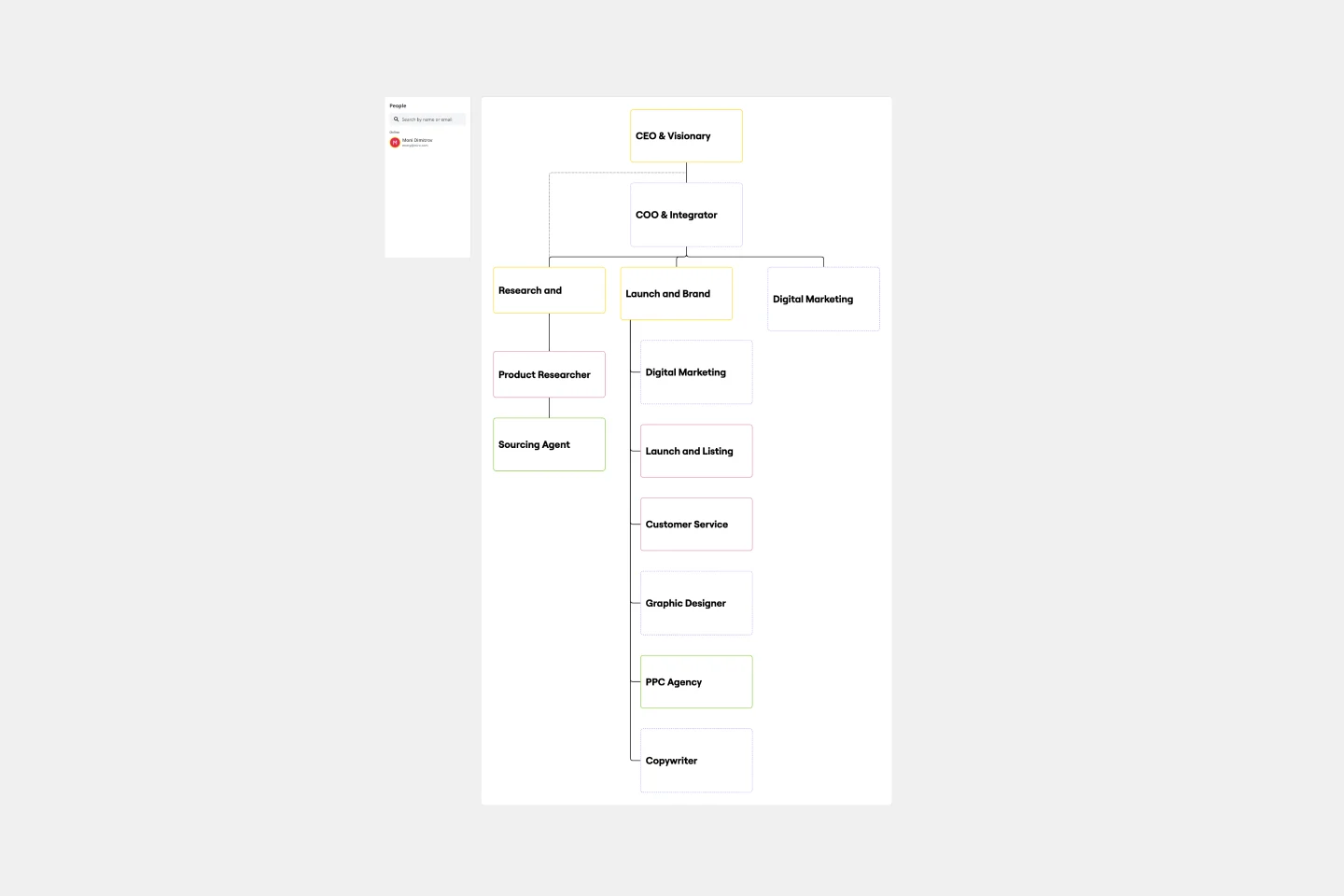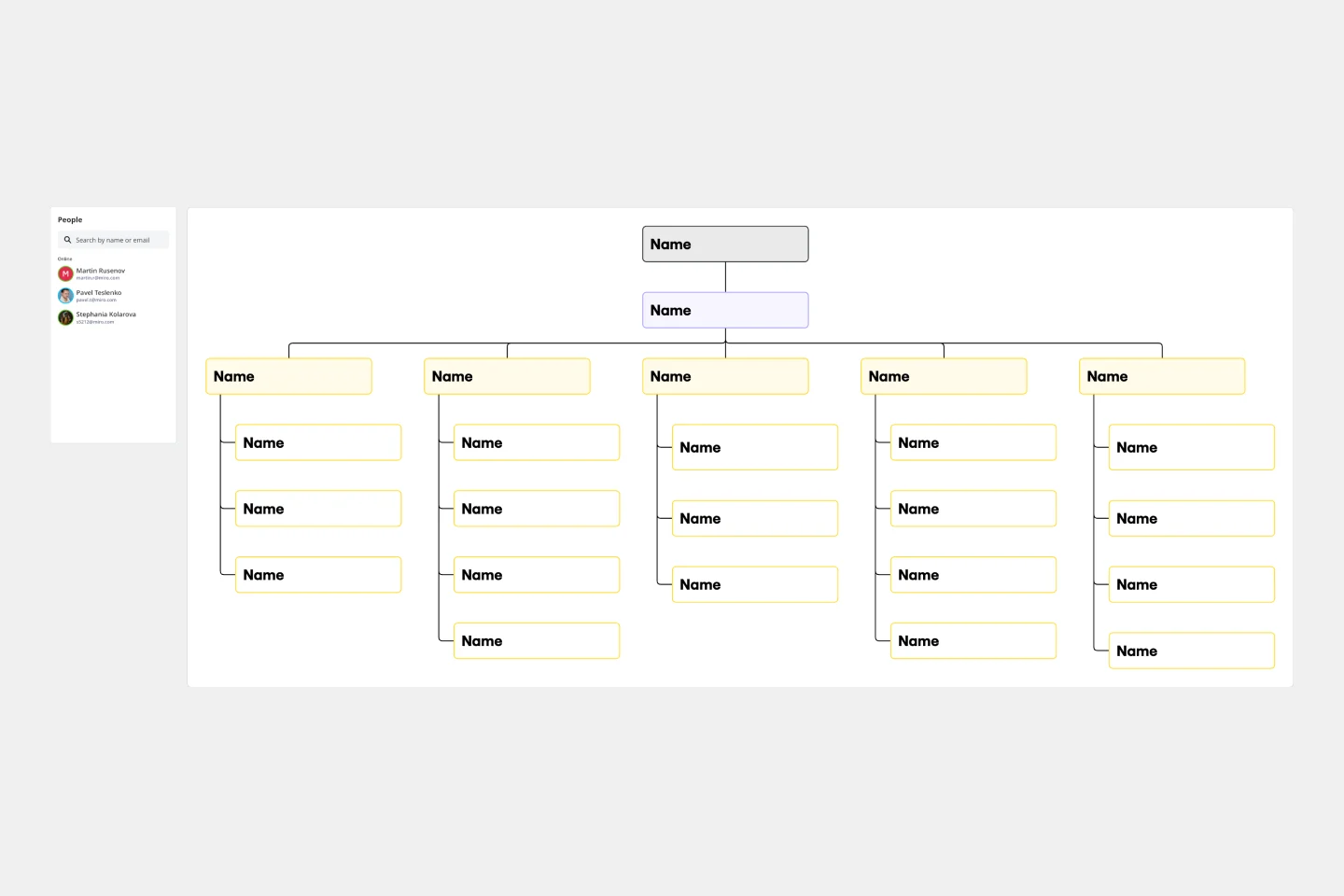About the Business Organizational Chart Template
You can structure your business organizational chart in a way that makes sense for your company and goals. For example, some companies are more hierarchical, while others are more "flat" and based on teams.
What is a business organizational chart?
Business Organizational Charts are used to map out and clarify the reporting hierarchy in a business. It shows the structure of the organization and the relationship between various parts. People use organizational charts for management, planning, or as a personnel directory.
Why should you use a business organizational chart?
Many companies use a business organizational chart to clarify roles and responsibilities. Overall, organizational charts are helpful for building and designing an organizational structure that meets your business’s objectives. They map out relationships between staff members and teams and show who reports to whom. Organizational charts empower employees to know their team members, learn about potential cross-functional collaborators, and understand who they should communicate with if they have a specific need.
What are the different types of business structure charts?
There are four types of business structure charts.
Functional top-down - A functional, top-down organizational structure is what comes to mind when you think of the traditional business structure. The C-Suite sits at the top, followed by senior management, middle management, and so on. The chart is divided into familiar departments like IT, finance, human resources, marketing, sales, and operations. Teams and individuals with similar skill sets are grouped together.
Divisional - A divisional organizational chart is used by companies that are organized along product lines or geography. For example, in a computer company, the divisions may consist of Hardware, Software, and so on. Each division then has its own divisional structure such as marketing and human resources.
Matrix - A matrix organizational chart is for companies in which employees are divided into teams based on the product they’re working on, but they also report to a functional manager. These companies operate cross-functionally instead of within vertical silos. Many companies use a matrix organizational structure to foster collaboration and open communication.
Flat - A flat organizational structure contains little to no hierarchy. There are few or zero levels of management between executives and employees. This type of structure, although rare, empowers individuals and teams to self-manage.
How to make a business organizational chart?
It's easy to make an organizational chart for your business using Miro. Simply follow these steps and you'll have a business organizational chart to share and present in no time.
Determine the high-level organizational structure of your company. Is it hierarchical or more matrixed? Do individuals have multiple roles? Once you've determined this structure, it's easy to create a visual representation of how different employees are interconnected.
Collect people’s information inside your organization and categorize it.
Decide how you will display the information in your business organizational chart. Miro's fully customizable business organizational chart template is a great starting point to fill in all the details.
Share it across your business organization. Be mindful that the business organizational chart is a living document and can and should be edited following changes inside your organization.
Business Organizational Chart FAQs
What’s a company’s hierarchy?
A company’s hierarchy is how the people inside your business are organized according to job function, department, region, and level.
What’s the best organizational structure for small businesses?
A small business organization can use any of the business structure charts mentioned above, functional, divisional, matrix, or flat. The role of a small business organizational chart is mainly to map the organization’s hierarchy to facilitate business operations and efficiency.
What’s the difference between organizational structure and organizational chart?
An organizational structure shows what the business does, and it’s designed around its functions, e.g., product, marketing, finance, etc. A business organizational chart is about the people and roles inside the organization.

Miro
Your virtual workspace for innovation
Miro is an innovation workspace designed for teams of every size, everywhere, to dream, design, and build the future together. Our mission? To empower these teams to create the next big thing, powered by AI at every step of the way. Over 90 million users around the world rely on Miro to untangle complex ideas, put customer needs first, and deliver products and services faster. All supported by best-in-class security, compliance, and scalability.
Categories
Similar templates
Organizational Chart Template

Organizational Chart Template
Who makes up the team? What roles do they play? Who does each member report to? An organizational chart, or org chart, can answer it all at a glance. Ideal for onboarding new employees, these visual diagrams plot out company structure and the chain of command to help your team members understand reporting relationships, their role, and how they fit into the broader organization. Our template lets you choose your own chart structure and easily plot the connections between employees, roles, and departments.
Accountability Chart Template

Accountability Chart Template
The Accountability Chart Template is a visual map detailing the various roles within an organization and the responsibilities tied to each. This systematic layout ensures clarity in defining duties and fosters a culture of accountability. A standout benefit of using this template is its capacity to eliminate role ambiguity. The Accountability Chart template ensures that every team member understands tasks by clearly depicting who is responsible for what. This leads to enhanced productivity and reduced task overlaps or missed assignments.
Team Charter Template

Team Charter Template
A team charter is a document that outlines your team’s purpose and objectives, as well as steps you will take to reach your goals. The team charter illustrates the focus and direction for all team members. When created collaboratively, the team charter is a great way for individuals to feel even more connected to one another within the group. A team charter template is useful when you’re first establishing a new team, adding new members to an existing team, or when you need to better align regardless of your team’s tenure.
Dotted Line Org Chart Template

Dotted Line Org Chart Template
The Dotted Line Org Chart Template promotes transparency by demonstrating a dynamic representation of dotted line reporting relationships. This feature allows users to display both direct and indirect connections within an organization in a visual format, which offers a better understanding of how roles intersect and work together. By incorporating dotted lines seamlessly into the chart, this template goes beyond traditional hierarchical structures to ensure that complexities in reporting are fully communicated.
Circular Org Chart Template

Circular Org Chart Template
The Circular Org Chart Template is an innovative solution that helps represent and visualize complex organizational structures with ease. The key advantage of this template is its ability to present complex hierarchies in a visually appealing and easy-to-understand format. By adopting a circular arrangement, the template provides a comprehensive and holistic view of the organization, making it effortless for teams to comprehend reporting relationships at a glance. The visual clarity offered by this template fosters efficient communication and decision-making, offering a seamless experience for teams to understand their organizational structure. The template's intuitive design and emphasis on visual representation significantly enhance transparency, promoting a deeper understanding of organizational roles and relationships.
Organizational Chart Template

Organizational Chart Template
Who makes up the team? What roles do they play? Who does each member report to? An organizational chart, or org chart, can answer it all at a glance. Ideal for onboarding new employees, these visual diagrams plot out company structure and the chain of command to help your team members understand reporting relationships, their role, and how they fit into the broader organization. Our template lets you choose your own chart structure and easily plot the connections between employees, roles, and departments.
Accountability Chart Template

Accountability Chart Template
The Accountability Chart Template is a visual map detailing the various roles within an organization and the responsibilities tied to each. This systematic layout ensures clarity in defining duties and fosters a culture of accountability. A standout benefit of using this template is its capacity to eliminate role ambiguity. The Accountability Chart template ensures that every team member understands tasks by clearly depicting who is responsible for what. This leads to enhanced productivity and reduced task overlaps or missed assignments.
Team Charter Template

Team Charter Template
A team charter is a document that outlines your team’s purpose and objectives, as well as steps you will take to reach your goals. The team charter illustrates the focus and direction for all team members. When created collaboratively, the team charter is a great way for individuals to feel even more connected to one another within the group. A team charter template is useful when you’re first establishing a new team, adding new members to an existing team, or when you need to better align regardless of your team’s tenure.
Dotted Line Org Chart Template

Dotted Line Org Chart Template
The Dotted Line Org Chart Template promotes transparency by demonstrating a dynamic representation of dotted line reporting relationships. This feature allows users to display both direct and indirect connections within an organization in a visual format, which offers a better understanding of how roles intersect and work together. By incorporating dotted lines seamlessly into the chart, this template goes beyond traditional hierarchical structures to ensure that complexities in reporting are fully communicated.
Circular Org Chart Template

Circular Org Chart Template
The Circular Org Chart Template is an innovative solution that helps represent and visualize complex organizational structures with ease. The key advantage of this template is its ability to present complex hierarchies in a visually appealing and easy-to-understand format. By adopting a circular arrangement, the template provides a comprehensive and holistic view of the organization, making it effortless for teams to comprehend reporting relationships at a glance. The visual clarity offered by this template fosters efficient communication and decision-making, offering a seamless experience for teams to understand their organizational structure. The template's intuitive design and emphasis on visual representation significantly enhance transparency, promoting a deeper understanding of organizational roles and relationships.